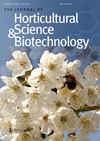摘前水果套袋:一种有效的植物保护和提高摘后水果品质的方法综述
IF 2.1
4区 农林科学
Q2 HORTICULTURE
Journal of Horticultural Science & Biotechnology
Pub Date : 2014-01-01
DOI:10.1080/14620316.2014.11513055
引用次数: 118
摘要
几种良好农业规范(GAP)在世界范围内越来越流行,以生产高质量的水果,减少对人造化学品的依赖。在这些做法中,收获前的水果袋装已成为一种有效的方法。套袋是一种物理保护方法,它不仅可以通过促进果皮着色和减少瑕疵来改善水果的视觉质量,而且可以改变水果发育的微环境,这可以对水果的内部品质产生几种有益的影响。收获前袋装水果还可以减少疾病、虫害和/或机械损伤、皮肤晒伤、水果开裂、水果上的农药残留和鸟类伤害的发生率。由于其许多有益的作用,水果套袋已成为日本、澳大利亚、中国和美国的桃、苹果、梨、葡萄和枇杷种植的一个组成部分。此外,墨西哥、智利和阿根廷等国不进口苹果,除非它们是袋装的。已经进行了几项研究,以确定收获前的水果袋装对果皮颜色发育和质量的理想影响,但报告的结果相互矛盾。这可能是由于所使用的袋的类型不同、袋装时果实的发育阶段不同、摘袋后果实暴露在自然光下的时间不同,以及/或果实和品种的特异性反应不同。装袋是费力的,必须调查其成本效益比,以便在世界大部分地区推广采用这种方法。这篇综述的目的是通过收集分散的信息来提高我们对不同水果套袋的有益效果的理解,以便更多的种植者可以考虑在商业规模上使用这种方法。本文章由计算机程序翻译,如有差异,请以英文原文为准。
Pre-harvest fruit bagging: a useful approach for plant protection and improved post-harvest fruit quality – a review
Summary Several good agricultural practices (GAP) are becoming popular throughout the World for the production of high quality fruit with less dependence on man-made chemicals. Among such practices, pre-harvest fruit bagging has emerged as an effective method. Bagging is a physical protection method which not only improves the visual quality of fruit by promoting skin colouration and reducing blemishes, but can also change the micro-environment for fruit development, which can have several beneficial effects on internal fruit quality. Pre-harvest bagging of fruit can also reduce the incidence of disease, insect pest and/or mechanical damage, sunburn of the skin, fruit cracking, agrochemical residues on the fruit, and bird damage. Due to its many beneficial effects, fruit bagging has become an integral part of peach, apple, pear, grape, and loquat cultivation in Japan, Australia, China and the USA. Moreover, countries such as Mexico, Chile, and Argentina do not import apples unless they are bagged. Several studies have been conducted to identify the desirable effects of pre-harvest fruit bagging on skin colour development and quality, but contradictory results have been reported. These may be due to differences in the type of bag used, the stage of fruit development when bagged, the duration of fruit exposure to natural light following bag removal, and/or fruit- and cultivar-specific responses. Bagging is laborious and its cost:benefit ratio must be investigated in order to promote adoption of the method in much of the World. The aim of this review is to improve our understanding of the beneficial effects of bagging in different fruit by collecting otherwise scattered information so that more growers could consider using this method on a commercial scale.
求助全文
通过发布文献求助,成功后即可免费获取论文全文。
去求助
来源期刊
CiteScore
3.90
自引率
5.30%
发文量
67
审稿时长
3 months
期刊介绍:
The Journal of Horticultural Science and Biotechnology is an international, peer-reviewed journal, which publishes original research contributions into the production, improvement and utilisation of horticultural crops. It aims to provide scientific knowledge of interest to those engaged in scientific research and the practice of horticulture. The scope of the journal includes studies on fruit and other perennial crops, vegetables and ornamentals grown in temperate or tropical regions and their use in commercial, amenity or urban horticulture. Papers, including reviews, that give new insights into plant and crop growth, yield, quality and response to the environment, are welcome, including those arising from technological innovation and developments in crop genome sequencing and other biotechnological advances.

 求助内容:
求助内容: 应助结果提醒方式:
应助结果提醒方式:


